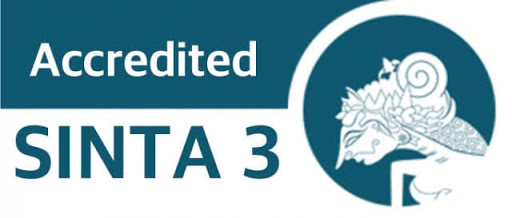DEVELOPING MIND MAPPING MODEL BASED ON PROPHETIC VALUES IN WRITING EXPOSITION TEXT
Abstract
This research and development aimed to achieve 2 main objectives: to develop a mind mapping model based on prophetic values in writing exposition texts, and to describe and discuss the profile of mind mapping model based on prophetic values in writing exposition texts. This model was developed by using 4D model (definition, design, development, and dissemination) which was modified to 3DI (definition, design, development, and implementation) . This research was conducted in the academic year 2019/2020 at a high school in Bandung. The instruments of this research were questionnaires and observation sheets that fulfilled the validity and reliability requirements. The initial product was tested on a limited trial in X IPA SMA Negeri 1 Baleendah Bandung. Then, the revised product was tested extensively in 2 classes, namely X IPA-3 and X IPS-5. The last procedure in this research was the dissemination of the final product prototype, which was teaching materials entitled Mind Mapping Based on Porphetic Values: Teaching Materials for Writing Exposition Texts for Grade X SMA/MA. This teaching material consisted of 30 pages, A4, time new roman, 12 automatic spaces outside the start page of 7. Ho was rejected for the paired sample t test because the sig. 0.037 < p = 0.05 for class X IPA-3 and the sig. 0.037 < p = 0.05 for class X IPS-5. Thisproduct was believed to contribute to the process of learning writing exposition texts at high schools. After that, as users, the Indonesian teachers scored in mode 4 for a scale of 1 to 4 for the 4 feasibility indicators. The score mode of 4 also occured in the assessment given by the expert team.
Keywords
Full Text:
PDF (BAHASA INDONESIA)References
Alwasilah, A. Chaedar & Sonny S. A. (2013). Pokoknya Menulis: Cara Baru Menulis dengan Metode Kolaborasi. Bandung: Kiblat.
Ariningsih, Nur Endah. dkk. (2012). Analisis Kesalahan Berbahasa Indonesia dalam Karangan Eksposisi Siswa Sekolah Menengah Atas. Basastra Jurnal Penelitian Bahasa, Sastra Indonesia dan Pengajarannya. Volume 1, Nonor 1, Desember 2012, 40-53.
Borg, W .R. & Gall, M. D. (1989). Educational Research: An Introduction. New York: Longman.
Budiaji, W. (2013). Skala Pengukuran dan Jumlah Responden Skala Likert. Jurnal Ilmu Pertanian dan Perikanan, 2(2), 127-133.
Crocker, L. & Algina, J. (1986). Introduction in Classical and Modern Test Theory. New York: Rinehart and Winston.
Dick, W. dkk. (2014). The Systematic Design of Instruction. Seventh Edition. New Jersey, USA: Pearson.
Iskandarwassid & Sunendar. (2008). Strategi Pembelajaran Bahasa. Bandung: Rosdakarya.
Maelasari, N. dkk. (2019). ‘Model Pembelajaran Mind Mapping berbasis Nilai Profetik bagi Peningkatan Kemampuan Menulis Eksposisi Siswa Kelas X SMAN I Baleendah Bandung’. Makalah. Bandung: Riksa Bahasa UPI XIII.
Muslich, M. (2010). Text Book Writing: Dasar-Dasar Pemahaman, Penulisan, dan Pemakaian Buku Teks. Jakarta: Ar-Ruzz Media.
Mulyati, Y. & Chayani, I. (2015). Keterampilan Berbahasa Indonesia SD: Buku Materi Pokok, PDGK4101/3SKS/1-9, Edisi II. Jakarta: Universitas Terbuka.
Razak, A. (2018). Membaca Pemahaman: Teori dan Aplikasi Pengajaran. Edisi Ketujuh. Pekanbaru: Ababil Press.
Razak, A. (2020). Statistika: Pengolahan Data Sosial Sistem Manual Cetakaan VIII, Edisi Ketujuh. Pekanbaru: Ababil Press.
Sarimanah, E. (2016). Efectivenes of PQ4R Metacognitive Strategy based Reading Learning Models in Junior High School. IJLECR International Journal of Language Education and Culture Review, 2(1), 74-81.
Syihabuddin. (2011). Pendidikan dan Bahasa dalam Perspektif Islam. Bandung: Rizqi.
Sudiati & Nurhidayah. (2017). Pengembangan Bahan Ajar Membaca Pemahaman Berdasarkan Strategi PLAN (Predict, Locate, Add, Note) untuk Kelas VII. Jurnal LITERA: Jurnal Penelitian Bahasa, Sastra, dan Pengajarannya, 16(1),114-128.
Sugiyono. (2015). Metode Penelitian Kuantitatif, Kualitatif, dan Kombinasi (Mixed Methods). Bandung: Alfabeta.
DOI: http://dx.doi.org/10.33578/pjr.v5i4.8437
Refbacks
- There are currently no refbacks.
Copyright (c) 2021 JURNAL PAJAR (Pendidikan dan Pengajaran)

This work is licensed under a Creative Commons Attribution-NonCommercial-ShareAlike 4.0 International License.
JURNAL PAJAR (Pendidikan dan Pengajaran)
Secretariat
Program Studi Pendidikan Guru Sekolah Dasar
Gedung B1, FKIP Universitas Riau
Kampus Bina Widya Km. 12,5 Simpang Baru Panam
Pekanbaru Riau Indonesia 28293
e-mail : pajar@ejournal.unri.ac.id



